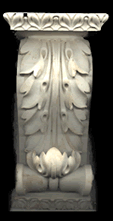




New England College of
Optometry,
Boston, MA.
When
the college restored this Italian Renaissance style residence, our work
included replacing plaster enrichments in the entrance hall, including a
stylized fleur-de-lis as field enrichment, triple interwoven crescents,
and various pendant festoons. In a separate area, water damage from above,
resulted in damage to the upper cornice acanthus run and frieze. Large
areas of the acanthus enrichment were replaced and the frieze repaired in
place
Weeks Summer House,
Mount Prospect, Lancaster, N. H.
This
White Mountain estate house, belonging to the Secretary of War for
President Harding, had a severe rising damp problem. The modern portland
stucco patches used to repair the exterior were failing. These patches
were removed and replaced with a historically correct lime render and
textured to match the original finish.
Twin Farms,
Barnard, VT.
Done
over as an exclusive retreat, the designer, Jed Johnson wanted to use
Venetian (pigmented) plasters. Paint chips were used to develop three
coloration formulas that were selected from one hundred fifty samples that
we provided to the designer. Lime-proof earth pigments were used for
coloration of the plasters
Thomas
Wolfe House,
Asheville, N. C.
After a devastating fire the interior needed to be rebuilt with in-kind replacements. I consulted on the scope of the needed to bring the house back, what materials were needed to preserve what was not destroyed, document what changes took place over the years, and how the specifications were written.